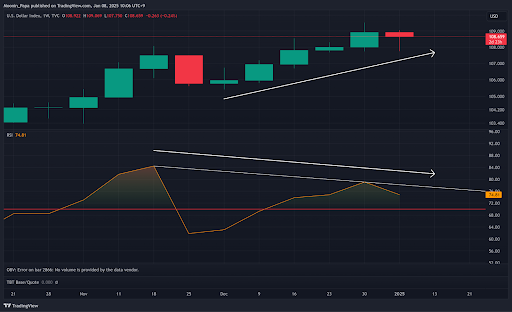Bitcoin's recent performance has taken a sharp turn, with a significant -6% drop yesterday. The move wiped out gains that had accumulated since the beginning of the year, leaving investors questioning what caused the decline and what it might signal about broader market trends. For metals investors exploring the crypto world, this event provides an opportunity to better understand how Bitcoin interacts with macroeconomic forces and how crypto markets behave during periods of heightened volatility.
Why Did Bitcoin Drop?
The decline didn’t result from Bitcoin testing significant resistance levels, such as the 1.272 Fibonacci extension—a price marker that often signals a turning point. Instead, broader macroeconomic factors likely drove the pullback. The U.S. Dollar Index (DXY), which tracks the strength of the dollar against other currencies, experienced a surprising rise. Historically, when the dollar strengthens, assets perceived as riskier, including Bitcoin and equities, tend to decline. The DXY’s strength stems from a U.S. economy that remains resilient. Recent economic data has suggested that the Federal Reserve may not cut interest rates as aggressively as the market had anticipated. As a result, global stocks and crypto assets faced selling pressure, while U.S. Treasury yields edged higher.
A Glimmer of Hope for Bitcoin
However, there is evidence that the dollar’s strength may be nearing a peak. Both daily and weekly technical indicators, such as the Relative Strength Index (RSI), show a divergence between the DXY’s rising price and its declining momentum. Divergence in this context suggests that the upward trend in the dollar could be losing steam. If the DXY tops out, it could relieve pressure on Bitcoin and allow it to regain its footing.
How Bitcoin Leads the Crypto Market
Bitcoin’s decline also reflects broader market sentiment. When the crypto market leader experiences sudden drops, other cryptocurrencies, often referred to as altcoins, tend to overreact. This phenomenon, known as the "Multiple Factor Effect," means that altcoins amplify Bitcoin’s moves. For example, while Bitcoin fell -6%, popular altcoins like Ethereum and NEAR experienced declines of -9% and -11%, respectively. This exaggerated reaction underscores the importance of focusing on Bitcoin as a market barometer.
Macro Trends Still Favor Bitcoin
Despite the short-term turbulence, Bitcoin’s overall trend remains intact. The cryptocurrency continues to exhibit long-term bullish signals, particularly on weekly timeframes, where macro trends become clearer. Metrics like the TBO (Trending Breakout) Slow Line, which tracks broader market movements, suggest that Bitcoin is still positioned for growth over the coming months.
What Metals Investors Can Learn
For metals investors, Bitcoin's pullback serves as a reminder of the asset's volatility. Unlike gold, which has a long history of acting as a hedge against inflation and economic uncertainty, Bitcoin remains more sensitive to macroeconomic shifts and investor sentiment. However, its ability to rebound quickly and its correlation to trends in the broader financial markets make it an asset worth observing closely.
Stablecoin dominance—a metric that reflects the portion of the crypto market moving into low-risk, dollar-pegged assets—also jumped sharply during Bitcoin’s decline. This shift highlights growing caution among crypto investors, echoing patterns seen in metals markets when traders retreat to cash during uncertain times. However, the macro trend for stablecoins remains bearish, suggesting that market participants are still optimistic about crypto’s long-term prospects.
Takeaways for the Broader Market
In the broader context, Bitcoin’s pullback illustrates the interconnectedness of financial markets. As the DXY moves, so too do assets like Bitcoin, gold, and equities. The rise of digital currencies alongside traditional safe-haven assets like gold underscores their shared susceptibility to macroeconomic forces while highlighting the differences in how they respond to such pressures. Bitcoin’s path forward depends largely on whether the dollar’s rally subsides and whether institutional trading desks return to the market with renewed interest. For now, the focus for investors—whether in metals or crypto—should remain on macro indicators, including the DXY and shifts in market sentiment, as these will likely dictate the next phase of Bitcoin’s journey.

